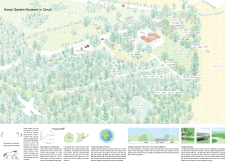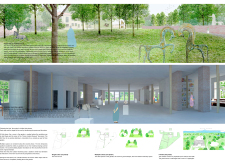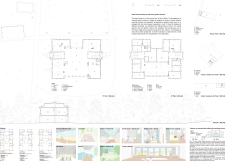5 key facts about this project
The Horse Garden Museum in Omuli, Latvia, offers a unique approach to exploring the relationship between humans and horses. Set across approximately 2 hectares, the museum aims to provide an educational experience that emphasizes the importance of equine life within a natural context. The design harmonizes structures with the surrounding landscape, creating an environment that encourages visitors to connect with both the animals and their habitat.
Architectural Concept
The architecture reflects a deep understanding of the connection between nature and horses. By incorporating elements common to horse habitats, such as pastures and gardens, the museum serves as a living space for both education and interaction. This thoughtful approach encourages exploration and promotes a richer understanding of how horses exist in their environments.
Geographical Integration
The design draws inspiration from the Latvian landscape, including features like wetlands, traditional farmhouses, and cultural saunas. This focus on geography helps visitors appreciate local heritage and ecological systems. The inclusion of these landscape elements throughout the site fosters a dialogue between constructed spaces and the natural world, creating a meaningful context for the museum.
Exhibition and Engagement Spaces
Various exhibition areas offer insights into horse-themed art and environmental education. These spaces allow visitors to engage creatively with the subject matter and explore artistic interpretations of equine life. The arrangement of installations invites wandering and interaction, enhancing the educational experience and encouraging a connection with nature.
Sustainability and Materiality
Sustainability is a key element in the museum's design, prioritizing methods to utilize natural light and ventilation effectively. While specific materials are not fully outlined, references to natural elements such as wood and glass suggest a focus on creating spaces that fit within the environment. This attention to sustainability not only reduces environmental impact but also fosters a welcoming atmosphere throughout the museum.
The museum culminates in inviting spaces, such as workshop areas within the garden and a guest house that rises above the landscape, providing unique views. These design details reflect a careful consideration for user experience while reinforcing the museum's mission to blend education with nature.






















































